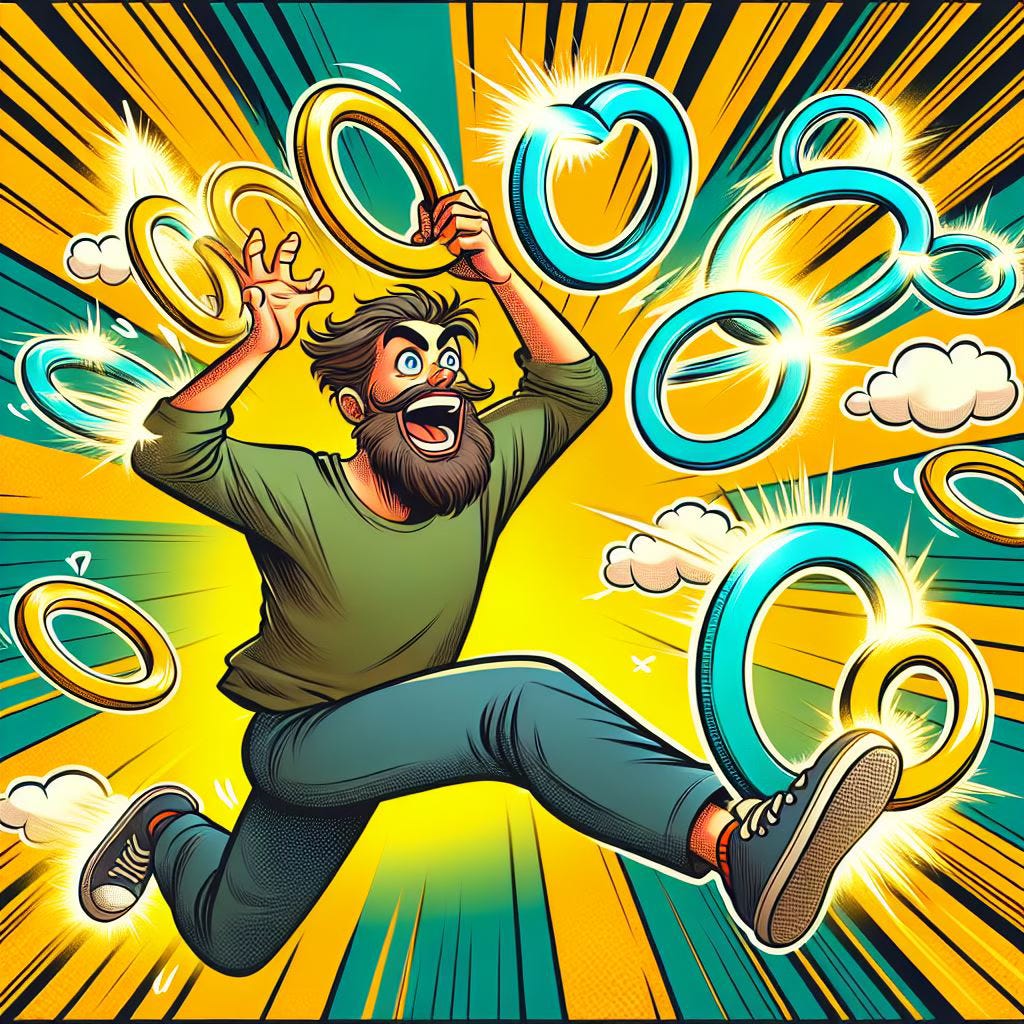How I nearly burned out as a Product Manager (and the six things that saved me)
Why doing a 'bad job' might be your best productivity hack, plus five other strategies to boost your resilience
This is my first article on product management, and I’ve gone straight in at the deep end with a thorny subject. High achievers get where they are by setting high standards for themselves, but if I’m totally honest, I’ve sometimes gone too far in pursuit of that bar. Investing too much of myself has at times knocked my resilience and made me question my career choice. Luckily, over the years I’ve learned some important coping strategies.
In this article I’m exploring how intentionally focusing on your productivity and resilience is key to surviving and thriving as a product manager.
So let’s get to the meat of the problem. What is it about product management that can be hard to deal with? Well, there are several stresses that can weigh on even the most experienced of product managers.
There is the high number of relationships to nurture. The needs of customers and the business can often be very real and very pressing. In a tough economic climate, there can be a sudden need to change course, or to do more with less. And then there’s the cognitive load of working right in the weeds across a wide range of sometimes very technical fields – far more than we can possibly develop strong expertise in ourselves.
That last point is the reason many people love product management, but it can also be particularly tricky. Depending on the team, PMs often need to lead or at least fully engage across a wide variety of disciplines. Product strategy, user research, software engineering, UX design, project management, go-to-market planning, sales enablement, stakeholder management, QA testing, copywriting, fostering a healthy team culture, data science, pricing, product evangelism, customer support, operations management, market analysis, quarterly planning, product analytics, assumption tracking, experimentation, regulatory compliance, supplier procurement, new technological capabilities and more and more. It’s an endless role that’s never ‘done’.
All that while our Slack is blowing up, and we’re distracted by other professional commitments. Write that status report, organise that team offsite, interview those candidates, write those annual performance reviews and help smooth things over with that tricky customer. Not to mention keeping up with commitments and curveballs in our personal lives too.
Imagine the levels of focus fracture, cognitive load and bandwidth depletion that we’re putting our brains through every day. Achieving great things under such conditions is tough, to say the least.
So, how do we do it?
This is a bad idea
Back in 2017, I attended one of Marty Cagan’s multi-day workshops about creating products that customers love. It was a defining moment in my career that totally changed how I approached product management, and placed Marty firmly in place as my number 1 product guru.
Amongst the nuggets that I immediately internalised at that workshop was “The real work of product management starts after 5pm.” Marty acknowledged that was a controversial thing to say, especially in Europe, but in his experience it really was true. It struck a chord with me.
So, how did I go about squaring my high standards and the ambitions of the various start-ups I worked at with the reality and scope of the role? Well, I worked long hours, almost every day. It was in the late evenings, with only the cleaners for company, that I had the opportunity to get deep into the weeds and make real progress.
But that strategy had its downsides. Most days I found myself eating all my meals in the office, and didn't have time to exercise. I declined invites from my friends on weekday evenings, expecting that I’d be working. And I didn’t give my family the attention that they needed.
Despite the extra hours, I still didn’t feel on top of everything. My to-do lists grew ever more saturated. I didn’t always get teammates what they needed on time. I struggled to switch my brain out of work mode when I got home, and I often struggled to get good quality sleep.
Those extra hours didn’t improve my performance; it did the opposite. A lack of rest made it harder for my brain to stay sharp, to concentrate on complex topics, or to regulate my emotions. On a few occasions I snapped at colleagues, and looking back I probably wasn’t all that fun to work with. Multiple line managers couldn’t give me any advice beyond productivity basics that felt hopelessly inadequate for my situation.
But I did find a way through. Whether any of those experiences sound familiar to you or not, I’m here to tell you that there are ways to reclaim your days, to be productive and to achieve high levels of output, all without tanking your resilience.
Here are the strategies that I’ve found to genuinely work.
1. Plan your focus
Your focus is a finite resource. If you’re anything like me, it's easily interrupted. Whilst I might feel busy, I’ve often looked back at my day and realised I didn’t really make progress on the areas I needed to.
The simplest way to focus on your highest priorities is to intentionally plan your day around those priorities. That helps you to be super clear on whether your current activity is moving you forward as you’d hoped, or if you’re avoiding your priorities and focusing elsewhere instead. That’s really the definition of procrastination.
When planning your day, acknowledge the realities that constrain what you can actually achieve. Accept that you need to spend time getting through messages. Accept that your energy levels dip at certain points in the day. Prefer to do your deep thinking in the early morning or late in the evening? Accept your personal constraints and ruthlessly plan your day around them.
Then stick to that plan. Find your flow state that keeps you focused on the task at hand. I know I reach my flow when I quit Slack, switch my phone to work mode, and pipe minimal techno through my headphones. Find what works for you.
The elephant in the room here is that it’s very likely that your day is already clogged up with meetings. Aligning your perfect schedule with other people is always tough. But if you set some clear expectations with your team (“only expect replies from me around lunchtime or after 4pm” or “I’m not available for meetings after 3pm”), then you may find a groove that works, and of course you can decide when to make an exception.
So: set boundaries, plan your focus and find your flow state to maintain that focus.
2. Close your "Open Loops"
This is another basic of productivity, but for me it’s a critical one. And as a product manager, I recommend you take it even further.
“Open loops” is a concept from David Allen's book "Getting Things Done", and refers to something that you need to keep in your mind. That might be a task you need to do, or some contextual information that you’ll need for that meeting in a couple of weeks.
The point here is to make sure that piece of information is immediately captured in the place where you’ll actually use it, so it’s not on your mind until that moment. That’s closing the loop. You’re aiming to reduce the things on your mind to help you to keep your focus where it’s needed.
As a product manager, you see so much rich information each day that is neither immediately relevant to your current focus, nor is obvious when nor how you’ll need it. That might be uncovering new customer contexts or pain points that aren’t related to your current objectives, or finding some interesting solution ideas that don’t solve the problems you’re working on right now. If you always stop to extend your customer journey maps and opportunity solution trees, or to start digging deeper on value or feasibility, then you’ve immediately moved your focus, and you’ll end up with sprawling discovery artefacts that are out of date by the time you come back to them.
Instead, develop a system where you can quickly capture these ideas and insights, with links to the original source, and tag them in a way that will make them easy to find when you need them. I've found that framing tags as high level opportunities, jobs to be done, or customer segments to be the best balance between quick to capture and easy to find. A Notion database is my tool of choice, but any system that lets you tag and organise notes will do the job.
3. Know when to do a bad job
I can credit Shreyas Doshi for this one. In his LNO framework, Shreyas recommends assigning your tasks to one of three categories:
L = Leverage. These are where you focus your time and attention, and where you’re aiming to do a great job.
N = Neutral. Do a good job on these, but no better.
O = Overhead. Just get it done. Actively try to do a bad job.
The helpful realisation for me was that for many of my tasks, the most important thing is that they just get done. It’s not worth me expending my time and focus on those tasks any more than is strictly necessary, but there is high value in ticking them off.
Personally, I don’t quite use Shreyas’s LNO categories. Instead I book high leverage tasks right into my calendar, to make sure I spend time on them. Even if it’s a few weeks out, they’re in my calendar. Then right at the top of my to do list, I have a section titled Quick Tasks. These are the items that I aim to do the smallest amount possible on, prioritising completion over quality. Reminding myself that I don’t need to do a good job on those tasks helps me to quickly move on to where my focus is needed more.
4. Step away from your laptop
Sometimes sitting at your laptop, even with the most intense focus, isn’t the best way to achieve a goal. When I need to understand dense new topics, to work through a complex problem, or to write a long document, I’ve come to realise that I’m much more productive if I close my laptop and walk away. Removing the screen shifts my brain into a different gear.
So after closing my laptop, I reach for one of the following techniques.
Talk through the problem with a colleague. An additional perspective always helps to highlight what’s important, and to understand new concepts there’s nothing better than having an expert explain it to you directly.
Draw pictures. I’m quite a visual thinker, so this is my natural go to. There’s nothing like mapping out the problem visually, with a pen and paper, or on a whiteboard, or with sticky notes, to help me clarify my thoughts, or to digest and understand complex topics.
Talk to an AI assistant, out loud. This is a great help when I need to write detailed documents. I like to explain my thoughts while walking, ask the AI to structure them into an outline, then iterate from there. It gets me from blank page to finished article in a fraction of the time. (Shout out to Tal Raviv for teaching me this one.)
5. Recognise your inner needs
I learned about the Inner Family Systems model from this article by Natalie Rothfels (subscription required).
The model conceptualises a bus that you’re driving, which is populated by different aspects of your personality. If everyone wants to go in the same direction, then great – you're on your way. But if some of those voices on the bus want to take you in a different direction, it can really slow down your progress.
Natalie advocates listening to and understanding those voices – even naming them, recognising that they’re valid, and then using the knowledge you gain to chart a path that takes all your bus passengers forward together.
I use that technique to understand when my inner optimist, distraction dragon or anxious child (amongst other bus passengers) is having an outsized impact on my focus. It helps me to understand when I need to change plan and course correct, and it's been a powerful tool in my resilience arsenal.
6. Prioritise the bigger picture
The reality of being more intentional with your focus is that you’re going to have to say no a lot. As product managers, prioritising is a core part of our role, so it’s not difficult to rationalise and explain those choices. But that doesn’t mean that it doesn’t feel bad. I’ve sometimes found myself striving to avoid letting people down, or chasing after their praise, at any expense.
A book that helped me to understand and deal with this was The Courage To Be Disliked, by Ichiro Kishimi and Fumitake Koga, which considers happiness through the lens of Adlerian psychology. These concepts in particular helped me to find balance and focus at work.
Your “work” is more than your job. Work in the home, childrearing, contributing to the local society, hobbies and all manner of other things are work. Paid employment is just one small part of that. To live in a way that acknowledges only paid work is a life that lacks harmony.
We shouldn’t consume ourselves with meeting the expectations of others. That’s a path to anxiety about how others see you, and in turn, how you see yourself. It can lead to inner needs that may be misaligned with where you need to “drive the bus”.
We find happiness by feeling helpful to a community. This for me is where we align ourselves to a higher purpose. It might be the success of your company, the health of your family, the prosperity of your country, the sustainability of the environment – or all the above and more at the same time. Adler believed that being an active participant in progressing those community goals is key to finding happiness.
Keeping these beliefs in mind helps me to prioritise and focus with purpose, and encourages me to maintain healthy relationships with others. Not relationships based on people pleasing, validation seeking, or the fear of letting someone down, but rather on supporting our collective purpose to a wider community.
You don’t have to choose between success and wellbeing
Finding productivity hacks that really work, and forcing myself to consider my own needs and humanity, has immeasurably helped me to become more resilient as a Product Manager. It’s no exaggeration to say that I wouldn’t still be in this career without those techniques.
So if you’re ever feeling on the edge of burnout, or can’t see a way to keep your head above water at work, I really hope that some of these techniques can help you to find a healthy way forwards.
Plan your focus
Close loops
Do a bad job
Ditch your laptop
Listen to the bus
Focus on the big picture
These strategies haven't just made me more productive; they've made my career sustainable.





